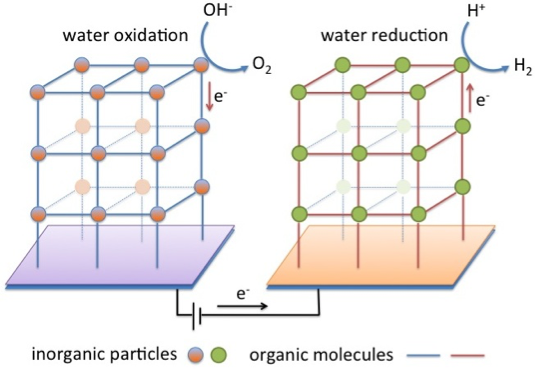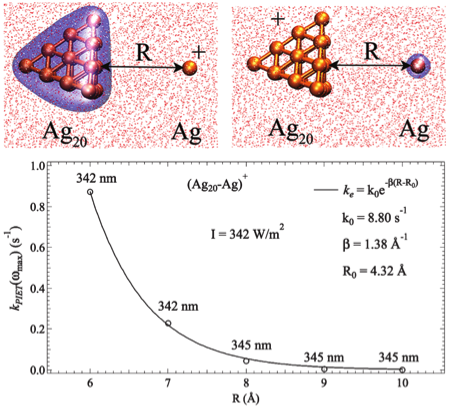Above: Light-Harvesting and Ultrafast Energy Migration in Porphyrin-Based Metal–Organic Frameworks.

Under the optoelectronics theme, we are concerned with the fundamental processes of light absorption/emission and photo-induced energy/charge transfer dynamics in systems that are relevant for light harvesting applications. These processes are modeled on different spatial and temporal length scales, and structural-property relationship is likewise built from the level of single molecules to supramolecular and mesoscale, and from the timescale of a few femtoseconds to several seconds. The materials of interest include metal organic frameworks (MOFs), self-assembling organic materials, molecular crystals, conducting polymers, biopolymers (DNA, proteins), quantum dot solids, and plasmonic systems.
The following projects highlight the current focus of the group.

Charge and Energy Transfer Dynamics: In weakly coupled supramolecular systems, such as adjacent linkers in metal-organic frameworks (MOFs), the Marcus and Forster Resonance Energy Transfer (FRET) equations can describe the rate of intermolecular charge and energy transfer, respectively. Charge transfer is usually accompanied by binding of counter ion from solvent, which effectively screens the excess charge. We have performed one of the first theoretical studies on charge and energy transport properties in MOFs for their potential applications as electrochemical catalysts and photovolatic materials.
Photoinduced electron transfer (PIET): In ultrafast PIET, the absorption of light induces the transfer of an electron between two systems. Since plasmonic nanoparticles have strong light absorption that is dependent on the size, shape, and chemical environment, we are particularly interested in modeling PIET from nanoparticles to molecules. Accurately predicting the PIET rate requires accurately modeling the energies of both the local excited states and the charge-transfer states. Although approaches such as TD-DFT can accurately model the local plasmon-like excited states on metal nanoparticles, the well-known failings of TD-DFT in predicting the energies of charge-transfer states make modeling PIET a challenge. Recent studies using approaches based on constrained DFT show that in a model [Ag20-Ag]+ system, the PIET rate decreases roughly exponentially as the interaction distance between the two moieties increases. We are currently evaluating the performance of other computational methodologies to predict and understand the chemical dependence of PIET rates.

Harnessing solar energy for practical applications requires converting the electromagnetic energy of light into electrochemical energy. Processes such as PIET where a photoinduced separation of charges can be used in a wide range of applications such as photovoltaic cells and photocatalysis. In dye-sensitized photovoltaic cells, PIET has been shown to give a 6-7x enhancement of photon conversion efficiencies. The use of plasmons near the dye molecules is an example of PIET and shows the increased extinction of the dye molecules is directly due to the strong fields of the plasmons.
Rebecca Gieseking, postdoctoral fellow
Recent Publications:
Patwardhan, S.; Schatz, G. C. Theoretical Study of Charge Transfer in Metal Organic Frameworks (MOFs) for Electrochemical Device Applications. Journal of Physical Chemistry C 2015, 119, 24238-24247.
Son, H.-J.; Jin, S.; Patwardhan, S.; Wezenberg, S. J.; Jeong, N. C.; So, M.; Wilmer, C. E.; Sarjeant, A. A.; Schatz, G. C.; Snurr, R. Q.; Farha, O. K.; Wiederrecht, G. P.; Hupp, J. T. Light-Harvesting and Ultrafast Energy Migration in Porphyrin-Based Metal–Organic Frameworks. J. Am. Chem. Soc. 2013, 135, 862-869.
Patwardhan, S.; Jin, S.; Son, H.-J.; Schatz, G. C. Ultrafast Energy Migration in Porphyrin-based Metal Organic Frameworks (MOFs). MRS Online Proceedings Library 2013, 1539, mrss13-1539-d06-06 doi:10.1557/opl.2013.987
Standridge, S. D.; Schatz, G. C.; Hupp, J. T. “Distance Dependence of Plasmon-Enhanced Photocurrent in Dye-Sensitized Solar Cells.” J. Am. Chem. Soc. 2009, 131, 8407-8409.
Khoa, N. T.; Kim, S. W.; Yoo, D. H.; Cho, S.; Kim, E. J.; Hahn, S. H. “Fabrication of Au/Graphene-Wrapped ZnO-Nanoparticle-Assembled Hollow Spheres with Effective Photoinduced Charge Transfer for Photocatalysis.” ACS Appl. Mater. Interfaces 2015, 7, 3524-3531.
Kelly, K. L.; Coronado, E.; Zhao, L. L.; Schatz, G. C. “The optical properties of metal nanoparticles: The influence of size, shape, and dielectric environment.” J. Phys. Chem. B 2003, 107, 668-677.
Aikens, C. M.; Li, S. Schatz, G. C. “From Discrete Electronic States to Plasmons: TDDFT Optical Absorption Properties of Agn (n = 10, 20, 35, 56, 84, 120) Tetrahedral Clusters.” J. Phys. Chem. C 2008, 112, 11272–11279.
Dreuw, A.; Head-Gordon, M. “Failure of Time-Dependent Density Functional Theory for Long-Range Charge-Transfer Excited States: The Zincbacteriochlorin-Bacteriochlorin and Bacteriochlorophyll-Spheroidene Complexes.” J. Am. Chem. Soc. 2004, 126, 4007-4016.
Chen, H.; Ratner, M. A.; Schatz, G. “Time-Dependent Theory of the Rate of Photo-induced Electron Transfer.” J. Phys. Chem. C 2011, 115, 18810-18821.
Chen, H.; Ratner, M. A.; Schatz, G. “QM/MM Study of Photoinduced Reduction of a Tetrahedral Ag20+ Cluster by a Ag Atom.” J. Phys. Chem. C 2014, 118, 1755-1762.
